Sarah Mary Fitton facts for kids
Quick facts for kids
Sarah Fitton
|
|
|---|---|
| Born | c. 1796 Dublin, County Dublin, Ireland
|
| Died | 30 March 1874 (aged 78) Paris, France
|
| Known for | Children's writer |
|
Notable work
|
Conversations on Botany (1817) |
Sarah Fitton (born around 1796 – died March 30, 1874) was an Irish writer and botanist. With help from her sister Elizabeth, Sarah Fitton wrote a famous book called Conversations on Botany in 1817.
This book was written like a series of chats between a mother and her son. They talked about plants and how to group them using the Linnaean taxonomy system. The book taught people how to identify plants and use them at home. It also helped make studying plants popular for women.
Life Story of Sarah Fitton
Sarah Mary Fitton was born in Dublin, Ireland. Her father, Nicholas Fitton, was a lawyer. She had a brother named William Henry Fitton and two sisters, Elizabeth and Susanna.
Sarah, her sisters, and her mother often moved to be near her brother William. He was a doctor and loved studying rocks and the Earth (a geologist). William was friends with many scientists, including the famous botanist Robert Brown.
In 1817, Sarah and Elizabeth Fitton published their book, Conversations on Botany.
Later, Sarah Fitton might have worked as a governess (a private teacher) in France. She wrote about this experience in her book How I became a governess (1861).
Besides her botany book, Sarah Fitton wrote other helpful books and short stories for children. Her book Conversations on Harmony (1855) was about music. It was published in both English and French. Another book, Little by Little (1857), taught children how to read music. Her last book came out in 1866.
Sarah Fitton also wrote short stories for a magazine called Household Words, which was run by the famous writer Charles Dickens. She lived in Paris, France, for a long time.
In Paris, Sarah Fitton met many interesting people. One friend, Elizabeth Barrett Browning, described Sarah in 1851 as "an elderly woman, shrewd and kind." Sarah Fitton passed away in Paris on March 30, 1874.
Her Books and Plant Studies
Sarah Fitton is best known for writing Conversations on Botany with her sister Elizabeth. This book was first published in 1817 and was so popular that it had nine editions by 1840.
The book has 18 conversations between a mother and her son. They learn about the Linnaean system of classification, which is a way to organize plants. They also learn about useful plants. This book, along with others from that time, helped more women become interested in studying plants.
The first few editions of Conversations on Botany did not say who wrote them. But later editions showed that Sarah Fitton wrote most of the book, with help from Elizabeth. Sometimes, people mistakenly thought other writers like Maria Elizabetha Jacson or Jane Marcet wrote it.
- Selected Plant Pictures by Thomas Milton
The first and second editions of the book had pictures engraved by Thomas Milton. Later editions, like the one from 1840, had pictures by the Sowerby family.
Sarah Fitton also wrote The Four Seasons: A short account of the structure of plants (1865). This book used ideas from Conversations on Botany but was written for a different group of people: members of the Working Men's Institute in Paris.
In 1865, a Belgian botanist named Eugène Coemans named a group of flowering plants Fittonia to honor the Fitton sisters. Later, in 1913, another botanist, Gustav Lindau, named a plant group from Africa Afrofittonia to honor them and the continent where it was found.












